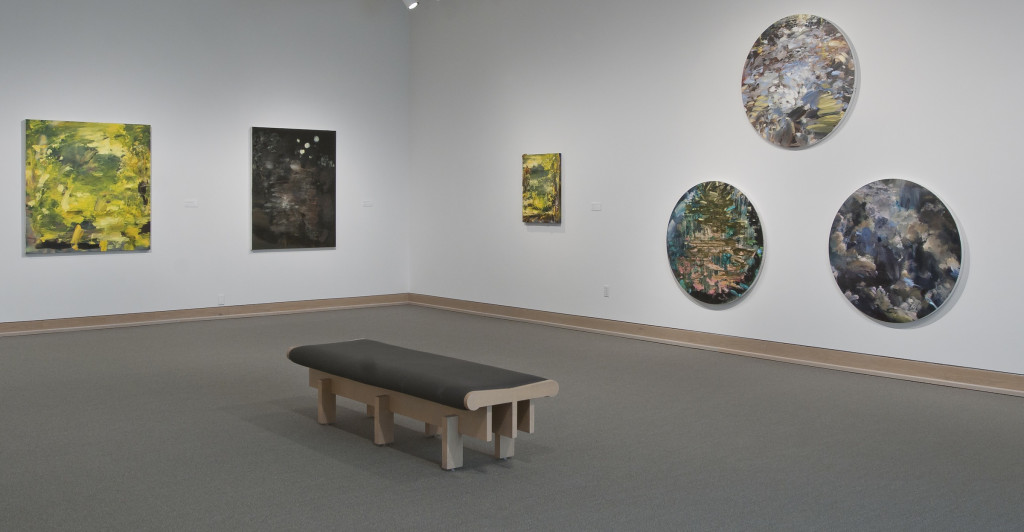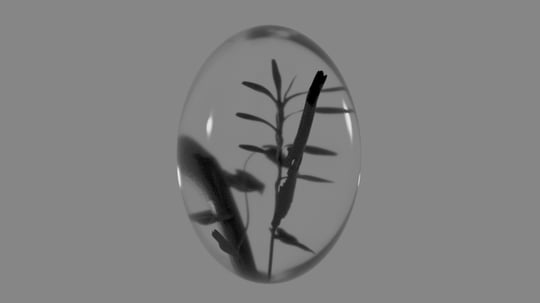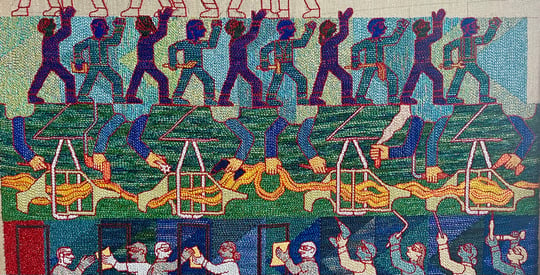
Los Angeles.
Because many artworks embody contradictory positions, articulating them as seemingly insurmountable polarities can be an unnecessary task, but it is one readily tackled by the authors of gallery press releases and museum wall labels. You know the type: “The artist’s practice explores surface and depth, concerns the personal and public, feels trendy yet timeless, is playful but serious.” As much as I’d like to escape the clutches of such statements, I can’t help but return to traditional dichotomies when viewing paintings by the prolific Los Angeles–based artist Annie Lapin.
In her ninth solo exhibition since receiving her MFA from the University of California–Los Angeles in 2007, Lapin offers 13 new and recent paintings on linen and canvas—six from 2011 and seven from 2013—that are mostly abstract but allude to representation. They have an unfinished look but are carefully made, and are steeped in art history but very much of the moment. Lapin wants to have it both ways, and often does exactly that.
In the newer work, Lapin has all but smudged out the figurative and representational elements. Five years ago the artist was painting groups of blurry figures lounging in equally blurry outdoor scenes; they suggest bathers in 19th-century French paintings but are probably just California hipsters hanging out in the park. She even made her own version of Manet’s notorious Luncheon on the Grass (1863), which she called Perverts (2009), that wryly excluded the original painting’s bourgeois gentlemen to focus exclusively on the two women. Lapin then segued into landscape, which preoccupied her for a couple of years before a turn toward full abstraction—but the countryside still looms large in her exhibition at the Weatherspoon Art Museum.
The daffodil yellows in The Bright Seeps Forward to Real (2013) and Over Gone Over (#1) (2013) shine brilliantly over a bed of forest greens. The two aren’t hung side by side, but you can still discern that they’re pictures of the same scene, except that the smaller work, Bright Seeps Forward, is detectable as a landscape—as if Richter painted a Corot with van Gogh’s palette. In contrast, the larger painting, Over Gone Over, dissipates into abstraction completely. Depicting another nature scene—sort of—is The Landly Animate (2011). I can see the browns of tree trunks with green and blue appropriately placed where sky and foliage should be, but what exactly are those brutish gray smears doing at the composition’s center, obscuring what’s already a muddied view? A trio of tondos from 2011 on the opposite side of the room provides solace, each work offering an impressionistic mess of Monet-like views of a forest floor, a sky, and a bush—at least that’s what the titles tell me.

Collection of Thao Nguyen, Los Angeles.
Across the flat linen of These Stock Lines (2013) Lapin has spread acrylic and oil paint—in deep blues and earth tones—with thick brushes and a palette knife, along with light touches of spray paint. With no trace of specific subject matter, the picture offers nothing more than itself, letting viewers obsess over the materiality of paint. There is virtually no smooth surface—the eyes scrape across the rough topography that has become its own terrain, spilling over and sticking to all four sides of the stretcher. Land Thing Mask (2013) also has rich hues: merlot purples, cabernet reds, and perky rosé pinks. This work, like its neighbor, It’s Puffed and Dripping (2013), proudly bears several bare patches of linen, suggesting that it’s not yet finished. But it is! This unresolved suspension is both curious and comforting.
The unfinished look has been all the rage in recent art, but Lapin stands in opposition to what Lane Relyea identifies as DIY abstraction, what Raphael Rubinstein terms provisional painting, and who Sharon L. Butler calls the New Casualists. Unlike those artists who fetishize effortlessness and randomness under the guise of a deskilled interest in process and materials, Lapin accepts the daunting challenge put forth from several centuries of art history, thereby joining several contemporaries who do the same: the expressive Angel Otero and Barnaby Furnas, the moody Kristine Moran, and the linear Tomma Abts and Tomory Dodge. Yet often works of art that are well made and historically informed are derided as portable, sellable commodities made for the art market. It’s true that Lapin’s small- and medium-sized works look great on the gallery wall and in the art-fair booth, and why shouldn’t they?
The best works in the exhibition come in pairs but transcend the oppositional predicament. I like The Vertical Dark (2011) and The Light Sanded Black (2011) mostly because they’re brooding and enigmatic, recalling the atmosphere of Whistler’s Nocturne in Black and Gold (ca. 1875). The other set of paintings, Air Pour Scrape (2013) and Thing that happens to memory (2013), is equally as fleeting. Both works are largely blue and white, colors that in Lapin’s oeuvre might signify a foaming waterfall or a bold sky blooming with clouds. The level of abstraction, though, makes it difficult to identify any subject—but it hardly matters anyway. For Lapin, ambiguity is strength.
“Annie Lapin: Falk Visiting Artist” remains on view at the Weatherspoon Art Museum, Greensboro, North Carolina, through January 5, 2014.
Christopher Howard is a critic, editor, and occasional curator based in Brooklyn, New York.






